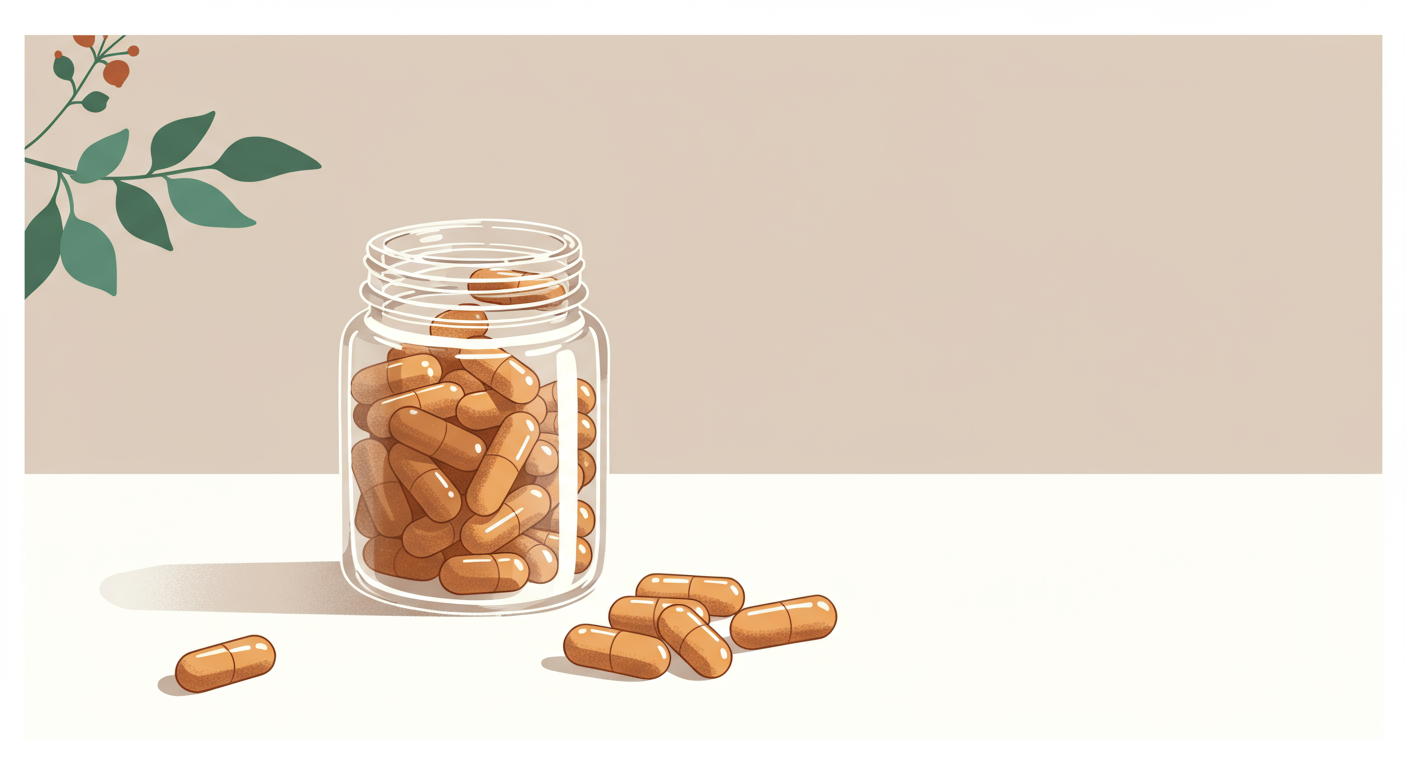Ashwagandha Dosing & Dangers: A Safe and Effective Usage Guide
Ashwagandha Dosing & Dangers: A Safe and Effective Usage Guide

Ashwagandha (Withania somnifera), an adaptogenic herb revered in Ayurvedic medicine, has gained significant popularity for its potential to help the body manage stress, improve sleep, and enhance physical performance. This comprehensive guide delves into safe and effective Ashwagandha usage, covering recommended dosages for various benefits, common forms, potential side effects, and vital safety precautions. Understanding these aspects is crucial for maximizing its benefits while minimizing risks, ensuring users make informed decisions about incorporating this powerful herb into their wellness routine.

Understanding Ashwagandha: An Adaptogenic Powerhouse
Ashwagandha, scientifically known as Withania somnifera, is a highly valued adaptogenic herb in Ayurvedic medicine. It's renowned for its ability to help the body manage stress and promote overall well-being. This section explores what Ashwagandha is, its historical significance, and the key compounds that contribute to its beneficial effects.
What is Ashwagandha?
Ashwagandha, a small shrub with yellow flowers, is native to India and North Africa. It is classified as an adaptogen, meaning it helps the body adapt to various stressors, promoting balance and resilience. Its name is derived from Sanskrit, meaning 'smell of the horse,' referring to its unique aroma and the belief that it imparts the strength and vigor of a horse.
Traditional Uses and Modern Research
For centuries, Ashwagandha has been a cornerstone of Ayurvedic healing, an ancient Indian system of medicine. Traditional uses range from boosting energy and reducing anxiety to improving concentration and overall vitality. Modern scientific research has begun to validate many of these traditional claims, focusing on the active compounds within Ashwagandha, primarily withanolides.
Common Forms of Ashwagandha Supplements
Ashwagandha is available in various forms, each with its own concentration and method of preparation. Understanding these differences is crucial for selecting the right supplement and achieving desired effects. The most common forms include raw root powder, standardized extracts, and specialized full-spectrum extracts.
Root Powder
Ashwagandha root powder is perhaps the most traditional form. It involves grinding the dried roots of the plant into a fine powder. This form is often used in traditional preparations, mixed with milk, honey, or water. Its potency depends entirely on the quality and concentration of the raw material, as it is not standardized for specific active compounds like withanolides.
Standardized Extracts (Capsules/Tinctures)
Extracts are a more concentrated form of Ashwagandha, typically found in capsules or tinctures. These extracts are often standardized to contain a certain percentage of withanolides, the primary active compounds. Standardization ensures a consistent potency, making it easier to dose and predict effects. Common standardization levels are 2.5% to 10% withanolides.
Full-Spectrum Extracts (KSM-66, Sensoril)
Full-spectrum extracts, like KSM-66 or Sensoril, are specific patented extracts that aim to capture the full profile of compounds found in the natural root, rather than just isolating withanolides. KSM-66 is an extract made solely from the root, while Sensoril uses both root and leaf. These proprietary blends are often well-researched and backed by clinical studies.
Note: Importance of Standardization
When choosing an Ashwagandha supplement, look for products that specify the concentration of withanolides. This indicates a standardized extract and helps ensure consistent potency. Higher quality products often undergo third-party testing for purity and potency.
Recommended Ashwagandha Dosages
Determining the correct Ashwagandha dosage is crucial for achieving desired results safely. Dosages can vary significantly based on the form of the supplement, its concentration of active compounds (withanolides), and the specific health goal. Always remember that consistency is often more important than high doses, as Ashwagandha’s benefits tend to accumulate over time.
General Dosage Guidelines
For general well-being and stress management, a common starting dosage for Ashwagandha standardized extract (containing 2.5-5% withanolides) ranges from 300 mg to 600 mg per day. This is often split into two doses. For root powder, the dosage might be higher, typically ranging from 1 to 3 grams daily. It's always best to start with the lowest effective dose and gradually increase it if needed, while monitoring your body's response.
Dosage for Stress and Anxiety
Several studies suggest that dosages between 250 mg and 600 mg per day of a standardized root extract can effectively reduce symptoms of stress and anxiety. For example, a study published in the Indian Journal of Psychological Medicine found that 600 mg of a high-concentration full-spectrum Ashwagandha root extract daily significantly reduced stress and cortisol levels. Consistent daily intake for several weeks is usually required to observe significant benefits.
Dosage for Sleep Improvement
Ashwagandha is increasingly used to improve sleep quality. Doses ranging from 300 mg to 500 mg of a standardized extract, taken shortly before bedtime, have shown promising results in promoting restful sleep and reducing sleep onset latency. Some research indicates that specific Ashwagandha compounds may support the GABAergic system, which is crucial for relaxation and sleep.
Dosage for Physical Performance
For enhancing physical performance, including strength and endurance, studies have often used doses of 500 mg to 600 mg of a standardized extract daily. One study in the Journal of the International Society of Sports Nutrition reported that 600 mg of Ashwagandha root extract per day improved muscle strength and recovery in healthy men. Athletes or individuals engaged in strenuous physical activity might benefit from these dosages.

Practical Advice on Taking Ashwagandha
Beyond dosage, how you incorporate Ashwagandha into your daily routine can influence its effectiveness. This section provides practical tips on consumption methods, timing, and considerations for long-term use.
With or Without Food?
Ashwagandha can generally be taken with or without food. However, taking it with food might help reduce the likelihood of stomach upset, especially for those new to the supplement. If you're taking multiple doses a day, splitting them (e.g., morning and evening) can help maintain consistent levels in your body.
Timing and Consistency
For stress and general well-being, taking Ashwagandha consistently every day is key. Benefits are typically observed after several weeks of continuous use, not immediately. For sleep, it is often recommended to take the dose about 30-60 minutes before bedtime.
Long-Term Use and Cycling
While Ashwagandha is generally considered safe for long-term use at recommended doses, some practitioners suggest cycling it (e.g., taking it for a few months, then a break for a few weeks). This practice is more common with certain supplements and can be discussed with a healthcare professional.
Potential Dangers and Side Effects
Like any supplement or medication, Ashwagandha can have side effects. While it's generally considered safe for most people when taken at recommended doses, it's important to be aware of potential adverse reactions. This section details both common and less common side effects.
Common Side Effects
While Ashwagandha is generally well-tolerated, some individuals may experience mild side effects, especially when starting or taking higher doses. These can include stomach upset, nausea, diarrhea, or vomiting. These symptoms are often transient and may be mitigated by taking Ashwagandha with food or reducing the dose.
Serious or Less Common Side Effects
More serious side effects are rare but possible. These can include liver problems, though reported cases are very few and often linked to pre-existing conditions or interactions. Some individuals might experience drowsiness, which can be beneficial for sleep but problematic if operating machinery. Allergic reactions, though uncommon, are also a possibility, manifesting as rash, itching, or swelling.

Who Should Avoid Ashwagandha? (Contraindications)
While beneficial for many, Ashwagandha is not suitable for everyone. Certain populations and individuals with specific health conditions should avoid or exercise extreme caution when considering Ashwagandha supplementation.
Pregnancy and Breastfeeding
Pregnant and breastfeeding women should avoid Ashwagandha due to insufficient safety data. Historically, Ashwagandha has been used to induce abortions in some traditional practices, though this is not supported by modern clinical evidence. Nevertheless, caution is paramount during these critical periods.
Autoimmune Diseases
Ashwagandha may stimulate the immune system, which could worsen symptoms in individuals with autoimmune diseases like rheumatoid arthritis, lupus, Hashimoto's thyroiditis, or multiple sclerosis. If you have an autoimmune condition, consult your doctor before taking Ashwagandha.
Thyroid Conditions
Ashwagandha can affect thyroid hormone levels, potentially increasing them. Individuals with hyperthyroidism or those taking thyroid medication should use Ashwagandha with extreme caution and under medical supervision.
Stomach Ulcers and Liver Disease
People with stomach ulcers or severe gastrointestinal issues should exercise caution, as Ashwagandha may irritate the digestive tract in some instances. Similarly, individuals with liver disease should consult a doctor, as rare cases of liver injury have been reported, although a direct causal link is not always clear.
Important: Consult Your Doctor
Always disclose all supplements, herbs, and medications you are taking to your healthcare provider. This allows them to assess potential interactions and ensure your safety.
Potential Interactions with Medications
Ashwagandha, despite its natural origin, can interact with various prescription and over-the-counter medications. These interactions can either enhance or diminish the effects of the medication, or even lead to adverse reactions. It is crucial to be aware of these potential interactions.
Sedatives and Alcohol
Ashwagandha may enhance the effects of sedative medications, including benzodiazepines, barbiturates, and other CNS depressants, potentially leading to excessive drowsiness. Similarly, it might intensify the effects of alcohol.
Thyroid Medications
Given its potential to influence thyroid hormone levels, Ashwagandha could interfere with thyroid replacement therapy (e.g., levothyroxine). Close monitoring by a physician is necessary.
Diabetes Medications
Because Ashwagandha can lower blood sugar levels, it may have an additive effect with diabetes medications, potentially leading to hypoglycemia ( dangerously low blood sugar). Diabetics should consult their doctor and monitor blood sugar carefully.
Immunosuppressants
As Ashwagandha can stimulate the immune system, it might counteract the effects of immunosuppressant drugs, which are prescribed to reduce immune activity (e.g., for organ transplant recipients or those with autoimmune conditions).
Blood Pressure Medications
Due to its potential effects on blood pressure, Ashwagandha might interact with anti-hypertensive medications, potentially leading to excessively low blood pressure.
Frequently Asked Questions About Ashwagandha
The effects of Ashwagandha are generally not immediate. Most people report noticing benefits, particularly for stress reduction and sleep improvement, after consistent daily use for 2 to 4 weeks, with optimal effects often observed after 6 to 8 weeks. Physical performance benefits might be noticed a bit sooner.
While Ashwagandha is known to improve sleep, some individuals might experience drowsiness as a side effect, especially when first starting or taking higher doses. If daytime drowsiness occurs, consider taking your dose in the evening or reducing the amount. Always avoid operating heavy machinery if you feel drowsy.
For most healthy adults, Ashwagandha is considered safe for daily, long-term use at recommended dosages. However, some individuals prefer to cycle off adaptogens for a week or two every few months. It's always best to consult with a healthcare professional, especially if you have underlying health conditions or are on other medications, to determine what's right for you.
Ashwagandha is often taken for its calming, stress-reducing properties. Combining it with caffeine, a stimulant, might seem counterproductive or could potentially exacerbate anxiety in some sensitive individuals. However, some people find that Ashwagandha can help 'take the edge off' the jitters from caffeine. Monitor your individual response carefully, and consider taking them at different times of the day.
Summary: Key Takeaways for Safe Ashwagandha Use
Navigating the world of supplements requires careful consideration, and Ashwagandha is no exception. To ensure safe and effective usage, keep these key points in mind:
- Start Low, Go Slow: Begin with the lowest effective dose and gradually increase it while monitoring your body's response.
- Choose Quality: Opt for standardized extracts (e.g., 2.5-10% withanolides) from reputable brands that offer third-party testing.
- Consistency is Key: Ashwagandha's benefits accrue over time; consistent daily use for several weeks is typically needed.
- Understand Your Form: Be aware of the difference between raw powder, standardized extracts, and full-spectrum extracts when considering dosage.
- Be Aware of Side Effects: While generally mild (stomach upset, drowsiness), be vigilant for any unusual or severe reactions.
- Know Your Contraindications: Pregnant/breastfeeding women, individuals with autoimmune diseases, thyroid conditions, stomach ulcers, or liver disease should exercise extreme caution or avoid Ashwagandha.
- Check for Interactions: Ashwagandha can interact with sedatives, thyroid medications, diabetes medications, immunosuppressants, and blood pressure medications. Always inform your doctor about your supplement regimen.
- Consult a Professional: Before starting any new supplement, especially if you have existing health conditions or are on medication, consult with a healthcare provider.